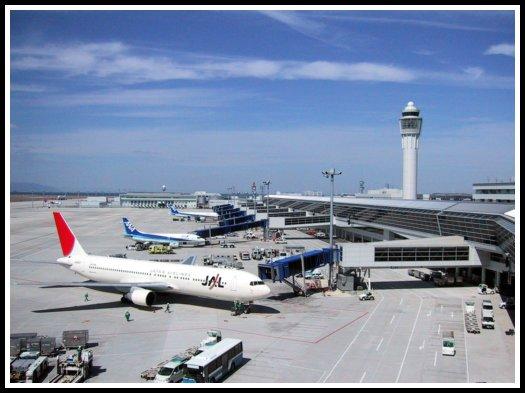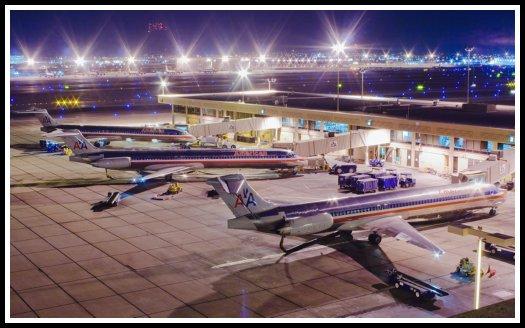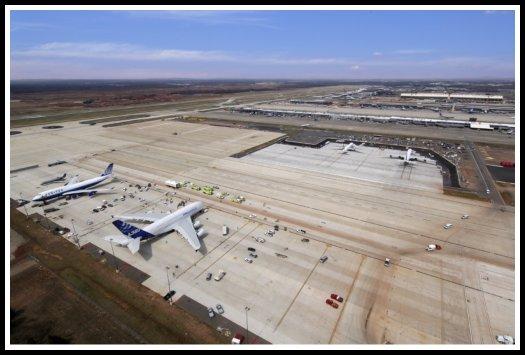Aircraft ground handling theory
London Heathrow has been described as the only building site to have its own airport.
- Anonymous.

Gates at Nagoya-Chūbu Centrair International Airport
Theory
Airline companies are the most important customers of any airport. Airlines can minimize their extra investment for growth by increasing aircraft daily utilization. Many low cost carriers define the standards for time-effective handling quite strictly. Most of them require turnaround time not to exceed 25 minutes for a standard Boeing 737 en-route operation. A well-known phrase "the airplane earns only when flying" holds true. Therefore, the basic requirements all airlines place on the ground handling are:
- to ensure safety of the aircraft, avoiding damage to it
- to reduce ground time
- to ensure high reliability of handling activities, avoiding delays
The airport administration authorities are also interested in reducing the ground time. In order to cope with an expected growth of air transport, most large European international airports will have to invest in further development of their infrastructure. Apron capacity is the limiting factor for some of them. It would, therefore, be more advantageous for them to reduce the ground time and thus increase apron and terminal productivity without significant investments. A possible solution could be an introduction of modern technologies for aircraft ground handling and new concepts of how to cut down delays at the airports. But there are many regional airports with one or only a few aircraft movements a day. When the requirements for technical handling at such airports are compared with those having busy air traffic, a considerable difference can be seen. The process of ground handling consists of a series of highly specialized activities. In order to carry them out, both highly skilled staff and sophisticated technical equipment are needed.

Three basic approaches to ground handling can be identified:
- the aircraft’s own technical equipment is used as much as possible
- mobile technical equipment of the airport is used - a "classical approach"
- airport fixed distribution networks with a minimum of mobile facilities, often called a "vehicle free apron".
Each of the above approaches has its advantages and disadvantages. Individual approaches can also be combined. The choice of a particular approach to ground handling is basically influenced by the following:
- airport size and its throughput
- type of flight, short and long-distance
- availability of capacity at the airport
- the intensity of utilization of a particular stand
- aircraft size
- extent of ground handling required, depending on whether it is a line or end station
- environmental concern of the population
For short flights which are served with modern jet or turboprop aircraft it may well be required that the total time allotted to the ground handling during a turnaround should not exceed 10 to 15 minutes. In such cases the aircraft’s on-board equipment such as airstairs and the Auxiliary Power Unit (APU) is used for the ground handling as much as possible. The number of ground handling activities is reduced to a minimum. Most turboprop aircraft serving short distance flights cannot use stands equipped with common passenger bridges owing to the distance of the left power plant from the bridge construction and a low door-sill height. At most medium-sized airports aircraft are serviced either by means of mobile equipment or through a combination of mobile systems and fixed ground systems. When compared with a complex installation of the fixed ground systems, the former solution requires less investment. This way of servicing an aircraft is preferred also at those airports where competition among several ground handling companies exists. In such a case only a few companies are ready to invest in ground support systems which will have to be shared with competitors, e.g. fuel systems. The largest vehicle on the stand is usually the fuel bowser. The location of the bowser should be clearly marked on the apron, and an exit route should always be available in a forward direction away from the aircraft. The APU exhaust efflux or other dangerous areas should be avoided.

Boeing 747 and Airbus A380 open stand parking concept
UTC | Zulu Time
Copyright © 2012 Roger. All rights reserved. | Sitemap